Sony A200 Review
Review Date: March 27th 2008
Author: Mark Goldstein
Leave a comment about this Review
|
Introduction
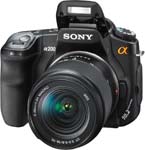
A surprise announcement back at the CES show in January, the A200 is Sony's second entry-level DSLR camera. The Sony A200 follows on from the A100, apparently one of the best-selling DSLR's of 2007, and it also forms the basis for two more advanced models, the A300 and A350, which were unveiled a month later at the PMA show. The A200 is now the cheapest Sony DSLR, building on the success of the A100 by using a smaller and lighter body, improving auto-focus performance (thanks to technology borrowed from the A700), increasing ISO speeds up to 3200, and featuring a slightly larger 2.7 inch LCD screen. There's also an optional vertical grip for portraits, something which the A100 sorely missed, and the flash now pops-up automatically. The A200 retains the 10 megapixel sensor, anti-dust system, anti-shake system that's built into the body, eye-start auto-focus system and Dynamic Range Optimiser of its predecessor. So with three new DSLRs, the beginning of 2008 may come to be seen as a pivotal moment for Sony. Mark Goldstein found out if the A200 is a good start to the year...
Compare Prices
Support PhotographyBLOG: Buy the Sony A200 from one of our affiliate retailers:Ease of Use
The Sony A200 attempts to build on the success of the popular A100 model and take a bigger slice of the entry-level DSLR market by tweaking the overall design, rather than radically altering it. Sony may have shocked industry watchers with its wholesale buy out of Konica Minolta at the start of 2006 – in order to play catch up and quickly narrow the gap – but it obviously saw something of value and that latter company's innovations sensibly haven't been forgotten. The A200 visibly pays respect to Konica Minolta's heritage, still resembling the Dynax/Maxxum 5D in looks and features, and perhaps most importantly by keeping the Minolta A-type lens mount (now of course the Alpha mount) it's cleverly afforded compatibility with a wealth of existing lenses.
The Sony A200 is slightly smaller and lighter than the A100, but it's still quite a big camera when compared to its main rivals, the Canon EOS 450D and Nikon D60. On its own the Sony A200 body weighs over 500g and measures 130.8 x 98.5 x 71.3 mm, rather dwarfing the standard 18-70mm f/3.5-5.6 kit lens, which feels a little lightweight and out-of-place in this company. Build quality is very good, with a chunky plastic body that is well-suited to two-handed operation, unlike some of the more diminutive DSLRs that we've seen recently. The A200's design is dominated by the very deep, chunky rubberised handgrip, and the large 2.7 inch LCD screen on the rear. There is a pronounced curve/indentation to the back of the body, allowing a comfortable resting position for the thumb when gripping the camera, while the indentations on the rubberized front of the grip – which houses both card (at the side) and chunky info lithium NP-FM55H battery (at the base) – means that it won't easily slip from your grasp in the heat of the action.
As with the older A100, the Sony A200 has inherited a number of core Konica Minolta technologies. In addition to the aforementioned lens mount that boasts day one compatibility with 28 years worth of existing lenses, Konica Minolta's pioneering Anti Shake technology, whereby optical image stabilisation is built into the camera body itself rather than the lens, has also been adopted. Here it's called Super SteadyShot, and it does much the same thing: adjusting for external hand-wobble by counter-moving the CCD in a compensating manner. I found during the review period that it's quite effective, resulting in more usable shots in low light conditions without flash than I thought possible, and giving the 2.5 shutter speed steps advantage that the marketing literature promises. Sony's system does offer a large advantage over the likes of Nikon and Canon, in that because it's built-into the camera body, it works with any lens that you attach to the camera, removing the need to buy more expensive lenses with anti-shake.
Finally, at the point of powering down, the A200's sensor vibrates to automatically shake off any dust that has found its way in when changing lenses or zooming in and out. As a further line of defence, the CMOS sensor's filter sports an anti-static coating. In the short term the anti-dust combo appears to work well, with a few very small particles of dust only visible at very small apertures. In spite of the Anti-Dust Technology, you'll still need to invest in some kind of third-party sensor cleaning solution to keep the image sensor completely free of unwanted dust, but it does keep the majority of dust off the sensor.
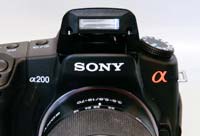 |
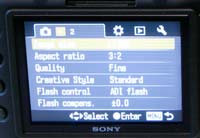 |
| Pop-up Flash | Main Menu |
The Sony A200 is quite complex in terms of the number of external controls that it has, with over 20 in total. The majority of the controls are clearly labeled and common to most cameras. There's a mode dial on the top-left of the camera that lets you quickly select the various shooting and scene modes. Also found on top of the camera are the Drive continuous shooting/bracketing button, very handy ISO button, and the shutter button, which is quite loud compared with other DSLRs and may deter some from using it for candids, but at least its definitive sound confirms for the less experienced user that the shot has actually been taken.
The A200 can shoot in continuous mode at a fairly respectable maximum of three frames per second, and the number of continuous sequential shots possible is limited only by the available memory when shooting Standard or Fine JPEG. When using RAW mode, the A200 maintains 3fps for up to 6 images. The Drive button also allows exposure bracketing of +/- 0.3EV or +/- 0.7EV, shooting three images with a single press of the shutter. It also takes three bracketed images for white balance. Notable by its absence is any kind of LCD panel on top of the camera to show what the current settings are, which is always useful. Instead you have to rely on the information displayed in the optical viewfinder or the more comprehensive information shown by default on the LCD screen. Finally, the pop-up flash housing now opens automatically when a flash mode is selected, and there's also an external flashgun hotshoe which includes a slip off plastic cover.
The Clear Photo LCD screen is a large 2.7 inch model with an adequate resolution of 230,000 pixels, a fairly wide viewing angle and visibility that isn't compromised by bright sun. Inset above the LCD is the equally bright and clear optical pentaprism viewfinder, surrounded by a spongy rubber eyepiece and with a small dioptric adjustment control ranged top right. The viewfinder displays standard shooting information along the bottom, with a central grid that illuminates in red which of the 9 point AF areas are being utilized. Beneath the viewfinder is a sensor that pre-focuses a shot as you bring your eye up to it (called Eye Start AF); a real boon for the happy snapper brigade, although you can turn this off if you don't get on with it. The new 9 point autofocus system, using technology borrowed from the prosumer A700 model, is noticeably faster and more accurate than the A100. The AF/MF button on the front of the camera lets you switch between auto and manual focusing.
Logically placed to the left of the optical viewfinder on the camera back is the Off/On switch. Flick it to on with your eye already to the viewfinder and you're ready to take the first shot in less than a second. Arranged in a vertical row immediately below are four buttons for bringing up the camera's menu folders on screen; activating, switching off or changing the view of the display settings; the last two being the self explanatory trash can and playback buttons. On the opposite side of the main LCD screen is a responsive four-way control pad for tabbing through and affecting change to settings or images. Above the navigation pad to the right of the viewfinder are the Exposure Compensation and Auto-Exposure Lock buttons, the latter locking the exposure in capture mode.
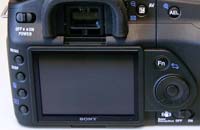 |
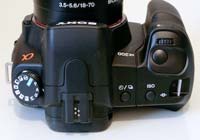 |
| Rear Controls | Top Controls |
Just below is the Function button, which provides quick access to most of the principal creative controls via the LCD screen. Press it once and the screen switches to Quick Navigation mode, allowing you to use the pad to move around and change the various settings shown on the LCD (Flash Mode, Metering Mode, Autofocus Mode, AF Area, White Balance and D-Range Optimiser). Although not as refined as the A700, it's still an excellent system that works really well, almost making up for the lack of a top LCD information screen. You can still access all of these options from the main menu system or a dedicated button too. The Function button also doubles up as the button that rotates captured landscapes to portrait ratio and vice versa. Tilt the camera on its side and the shooting info on the LCD automatically rotates through 90° with you.
If the A200 is set to Manual shooting mode, the control dial near the shutter button controls the shutter speed, with aperture set by holding down the exposure compensation button and then using the same control dial. In aperture- and shutter-priority modes, the front dial can be used to set the aperture and shutter speed respectively. Completing the rear controls is the large Super SteadyShot on/off switch, located below the navigation pad, which like the main power switch requires a reassuringly firm flick of the thumb, meaning that accidental activation or deactivation isn't a problem.
On the left-hand side of the camera body sits a large rubber flap, covering a port for a remote release cable, and a DC-in port for a mains power adaptor. Unlike the more expensive A700 model, there is no HDMI functionality on this camera. On the right side is the CompactFlash slot. As this is a DSLR, no memory card is included with the camera itself. For the purposes of my review, I was shooting to an 8GB compact flash card with a mixture of RAW, simultaneous RAW+JPEG and, for sample images, the Fine JPEG mode. Pleasingly, write speeds for the different file formats appear nigh on instantaneous, meaning that in single shot mode you're not conscious of the camera processing the first image before you can take the second.
Finally, moving to the bottom of the camera, we find the metal tripod socket, ideally positioned in-line with the middle of the lens mount, and the battery compartment. The Sony A200 uses a new InfoLITHIUM rechargeable battery pack, which still delivers up to 750 shots between charges, but can additionally display the remaining battery life on the LCD screen as a percentage, so that you always know how much power is left.
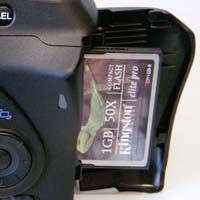 |
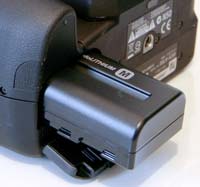 |
| Memory Card Slot | Battery Compartment |
Sony's D-Range (Dynamic Range) Optimiser adjusts brightness or contrast across the whole scene and is claimed to be particularly effective for high contrast, backlit scenes. When shooting in either JPEG or RAW, the Standard mode improves shadow detail using standard gamma curves, with the Advanced mode providing a more exaggerated effect. Take a look at the Image Quality page for some examples of the various DRO settings.
The main camera menu system on the Sony A200 is accessed by pressing the Menu button on the rear of the camera. As expected from a Sony digital camera, these are cleanly and logically structured. There are four main menus, Camera, Custom, Play and Setup. All of the camera's main options, such as white balance, image quality, auto-focus mode and ISO speed, can be accessed here, so the Camera menu has 11 options spread over 2 screens, the Custom menu has 6 options, the Play menu 9 and the Setup menu 14. Due to the large LCD screen and restricting the number of on-screen choices to 6, the various options and icons are clear and legible. If you have never used a digital camera before, or you're upgrading from a more basic model, reading the easy-to-follow manual before you start is a good idea. Thankfully Sony have chosen to supply it in printed format, rather than as a PDF on a CD, so you can also carry it with you.
Once you have captured a photo, the Sony A200 has a fairly good range of options when it comes to playing, reviewing and managing your images. You can instantly scroll through the images that you have taken, view thumbnails, zoom in and out up to 12x magnification, view slideshows, delete, protect, rotate an image and set the print order. The Display button toggles between no information, a simple settings information screen, a Histogram screen showing a combination of brightness and RGB histograms plus small image and key camera settings, and five small thumbnails above the main image.
In summary the Sony A200 is a modest upgrade of an already proven design, significantly adding faster and more accurate auto-focusing, a refined control layout, and a number of other minor improvements. Find out now if the image quality has also been improved...
|
![]() PhotographyBLOG
is a member of the DIWA
organisation. Our test results for the Sony A200 have been submitted to DIWA
for comparison with test results for different samples of
the same camera model supplied by other DIWA
member sites.
PhotographyBLOG
is a member of the DIWA
organisation. Our test results for the Sony A200 have been submitted to DIWA
for comparison with test results for different samples of
the same camera model supplied by other DIWA
member sites.
